Implication of Directly Connected Impervious Areas to the Mitigation of Peak Flows in Urban Catchments
Abstract
:1. Introduction
2. Methodology
2.1. Study Area and Land Cover Data
2.2. Land Cover Data and Estimation of DCIA
2.3. Hydrological Modeling Using WFIUH and SWMM
3. Results and Discussion
3.1. Estimation of DCIA with Stepwise Methods
3.2. Hydrological Response Estimation with WFIUH
3.3. Resulting Direct Runoff Hydrographs Depending on Implementation Scenarios of Green Infrastructure
4. Conclusions
Acknowledgments
Author Contributions
Conflicts of Interest
References
- Boyd, M.J.; Bufill, M.C.; Knee, R.M. Pervious and impervious runoff in urban catchments. Hydrol. Sci. J. 1993, 38, 463–478. [Google Scholar] [CrossRef]
- Roy, A.H.; Shuster, W.D. Assessing impervious surface connectivity and applications for watershed management. J. Am. Water Resour. Assoc. 2009, 45, 198–209. [Google Scholar] [CrossRef]
- Schueler, T.R. The importance of imperviousness. Watershed Prot. Tech. 1994, 1, 100–111. [Google Scholar]
- Arnold, C.L.; Gibbons, C.J. Impervious surface coverage: The emergence of a key environmental indicator. J. Am. Plan. Assoc. 1996, 62, 243–258. [Google Scholar] [CrossRef]
- Urbona, B.R. Urban Runoff Quality Management; American Society of Civil Engineers: Reston, VA, USA, 1998. [Google Scholar]
- Mays, L.W. Stormwater Collection Systems Design Handbook, 1st ed.; McGraw-Hill: New York, NY, USA, 2001. [Google Scholar]
- Dunne, T.; Leopold, L.B. Water in Environmental Planning, 1st ed.; W. H. Freeman: San Francisco, CA, USA, 1978. [Google Scholar]
- Gordon, N.D.; Finlayson, B.L.; McMahon, T.A. Stream Hydrology: An Introduction for Ecologists, 2nd ed.; Wiley: Chichester, West Sussex, UK, 2004. [Google Scholar]
- Leopold, L.B. A View of the River; Harvard University Press: Cambridge, MA, USA, 1994. [Google Scholar]
- Boyd, M.J.; Bufill, M.C.; Knee, R.M. Predicting pervious and impervious storm runoff from urban drainage basins. Hydrol. Sci. J. 1994, 39, 321–332. [Google Scholar] [CrossRef]
- Seo, Y.; Choi, N.J.; Schmidt, A.R. Contribution of directly connected and isolated impervious areas to urban drainage network hydrographs. Hydrol. Earth Syst. Sci. 2013, 17, 3473–3483. [Google Scholar] [CrossRef]
- Lee, J.G.; Heaney, J.P. Estimation of urban imperviousness and its impacts on storm water systems. J. Water Res. Plan Manag. 2003, 129, 419–426. [Google Scholar] [CrossRef]
- Brabec, E.; Schulte, S.; Richards, P.L. Impervious surfaces and water quality: A review of current literature and its implications for watershed planning. J. Plan. Lit. 2002, 16, 499–514. [Google Scholar] [CrossRef]
- Walsh, C.J. Protection of in-stream biota from urban impacts: Minimise catchment imperviousness or improve drainage design? Mar. Freshw. Res. 2004, 55, 317–326. [Google Scholar] [CrossRef]
- Walsh, C.J.; Fletcher, T.D.; Ladson, A.R. Stream restoration in urban catchments through redesigning stormwater systems: Looking to the catchment to save the stream. J. N. Am. Benthol. Soc. 2005, 24, 690–705. [Google Scholar] [CrossRef]
- United States Environmental Protection Agency (USEPA). Available online: https://www.epa.gov/green-infrastructure/ (accessed on 12 January 2017).
- Roesner, L.A.; Bledsoe, B.P.; Brashear, R.W. Are best-management-practice criteria really environmentally friendly? J. Water Res. Plan Manag. 2001, 127, 150–154. [Google Scholar] [CrossRef]
- Booth, D.B.; Hartley, D.; Jackson, R. Forest cover, impervious-surface area, and the mitigation of stormwater impacts. J. Am. Water Resour. Assoc. 2002, 38, 835–845. [Google Scholar] [CrossRef]
- Carter, T.; Jackson, C.R. Vegetated roofs for stormwater management at multiple spatial scales. Landsc. Urban Plan. 2007, 80, 84–94. [Google Scholar] [CrossRef]
- Mayer, A.; Shuster, W.D.; Beaulieu, J.; Hopton, M.; Rhea, L.K.; Thurston, H.; Roy, A.H. Building green infrastructure via citizen participation—A six-year study in the shepherd creek. Environ. Pract. 2012, 14, 57–67. [Google Scholar] [CrossRef]
- Alley, W.M.; Veenhuis, J.E. Effective impervious area in urban runoff modeling. J. Hydraul. Eng. 1983, 109, 313–319. [Google Scholar] [CrossRef]
- Dinicola, R.S. Characterization and Simulation of Rainfall-Runoff Relations for Headwater Basins in Western King and Snohomish Counties, Washington; Department of the Interior, U.S. Geological Survey: Reston, VA, USA, 1990.
- Sutherland, R.C. Methods for estimating the effective impervious area of urban watersheds. Pract. Watershed Prot. 2000, 32, 193–195. [Google Scholar]
- EPA’s Methodology to Calculate Baseline Estimates of Impervious Area (IA) and Directly Connected Impervious Area (DCIA) for Massachusetts Communities; United States Environmental Protection Agency: Washington, DC, USA, 2010.
- Estimating Change in Impervious Area (IA) and Directly Connected Impervious Area for Massachusetts Small MS4 Permit; United States Environmental Protection Agency: Washington, DC, USA, 2014.
- Prisloe, M.; Giannotti, L.; Sleavin, W. Determining impervious surfaces for watershed modeling applications. Presented at the 8th National Nonpoint Source Monitoring Conference, Hartford, CT, USA, 10–14 September 2000. [Google Scholar]
- Sahoo, S.N.; Sreeja, P. Determination of effective impervious area for an urban Indian catchment. J. Hydrol. Eng. 2016, 21. [Google Scholar] [CrossRef]
- Naden, P.S. Spatial variability in flood estimation for large catchments: The exploitation of channel network structure. Hydrol. Sci. J. 1992, 37, 53–71. [Google Scholar] [CrossRef]
- Seo, Y. The effect of rainstorm movement on urban drainage network runoff hydrographs. Hydrol. Process. 2012, 26, 3830–3841. [Google Scholar] [CrossRef]
- Seo, Y.; Schmidt, A.R. Application of Gibbs’ model to urban drainage networks: A case study in southwestern Chicago, USA. Hydrol. Process. 2014, 28, 1148–1158. [Google Scholar] [CrossRef]
- Yen, B.C.; Akan, A.O. Hydraulic design of urban drainage systems. In Hydraulic Design Handbook; Mays, L.W., Ed.; McGraw-Hill: New York, NY, USA, 1999. [Google Scholar]
- Franchini, M.; OConnell, P.E. An analysis of the dynamic component of the geomorphologic instantaneous unit hydrograph. J. Hydrol. 1996, 175, 407–428. [Google Scholar] [CrossRef]
- Da Ros, D.; Borga, M. Use of digital elevation model data for the derivation of the geomorphological instantaneous unit hydrograph. Hydrol. Process. 1997, 11, 13–33. [Google Scholar] [CrossRef]
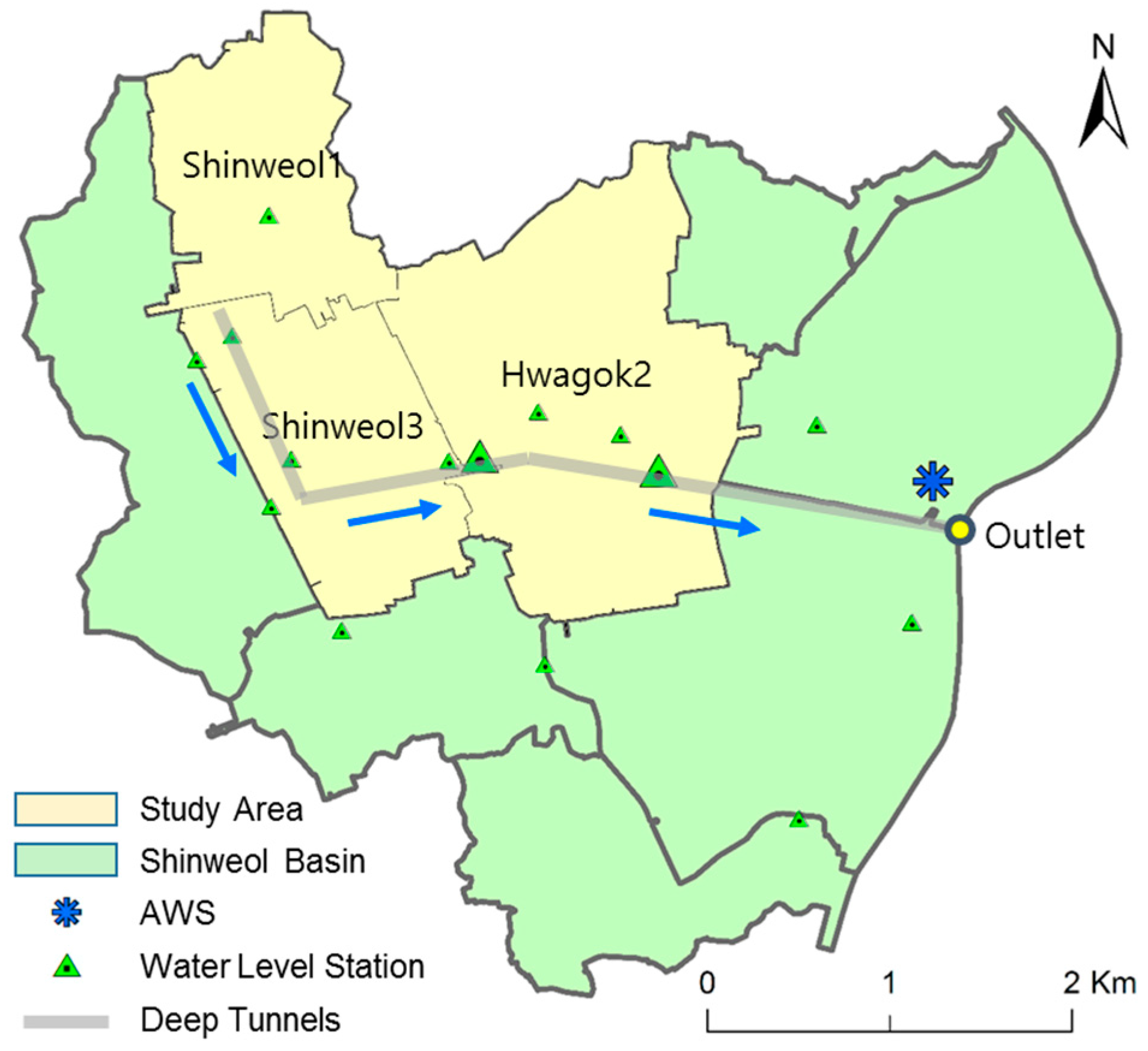
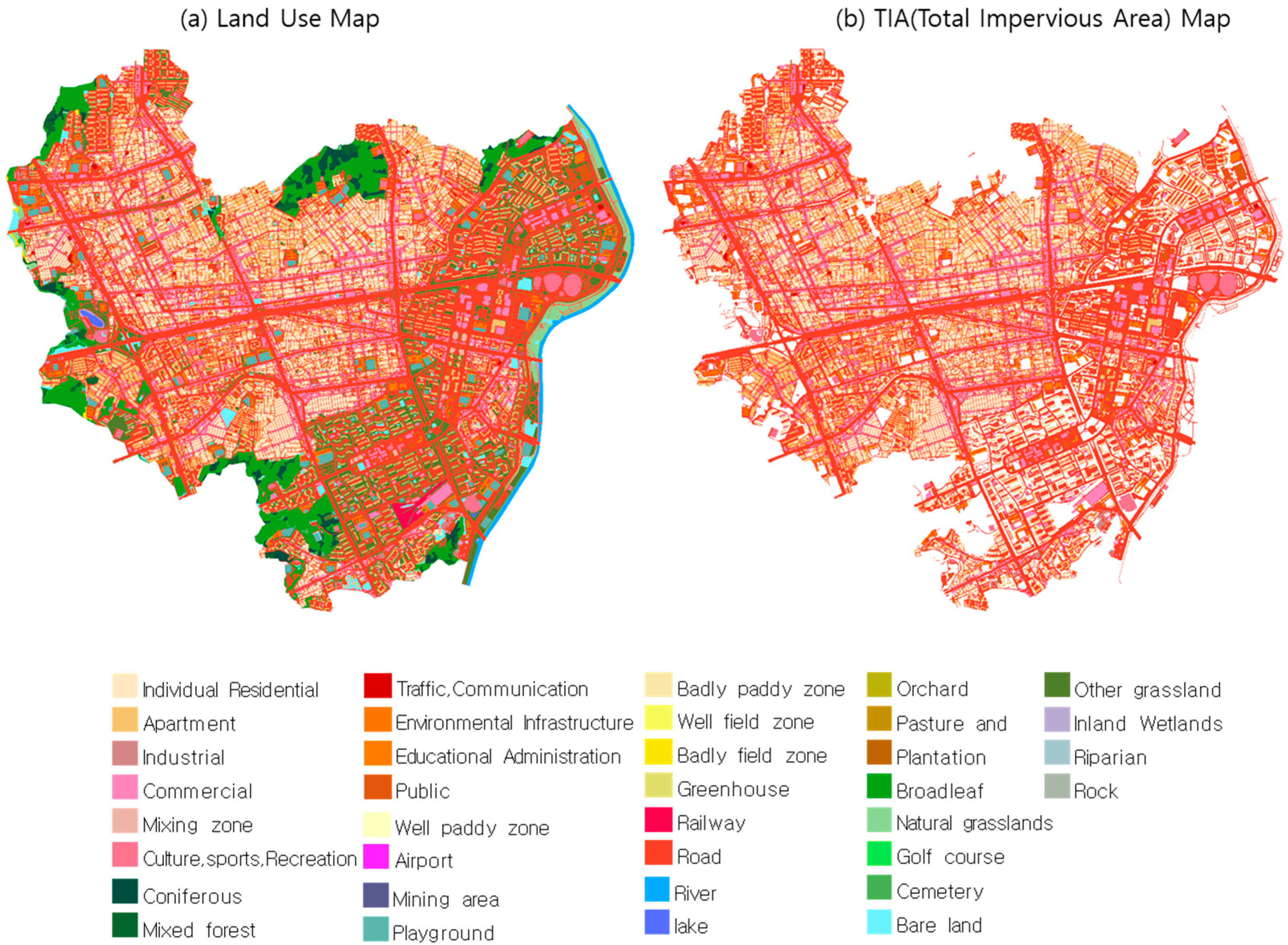


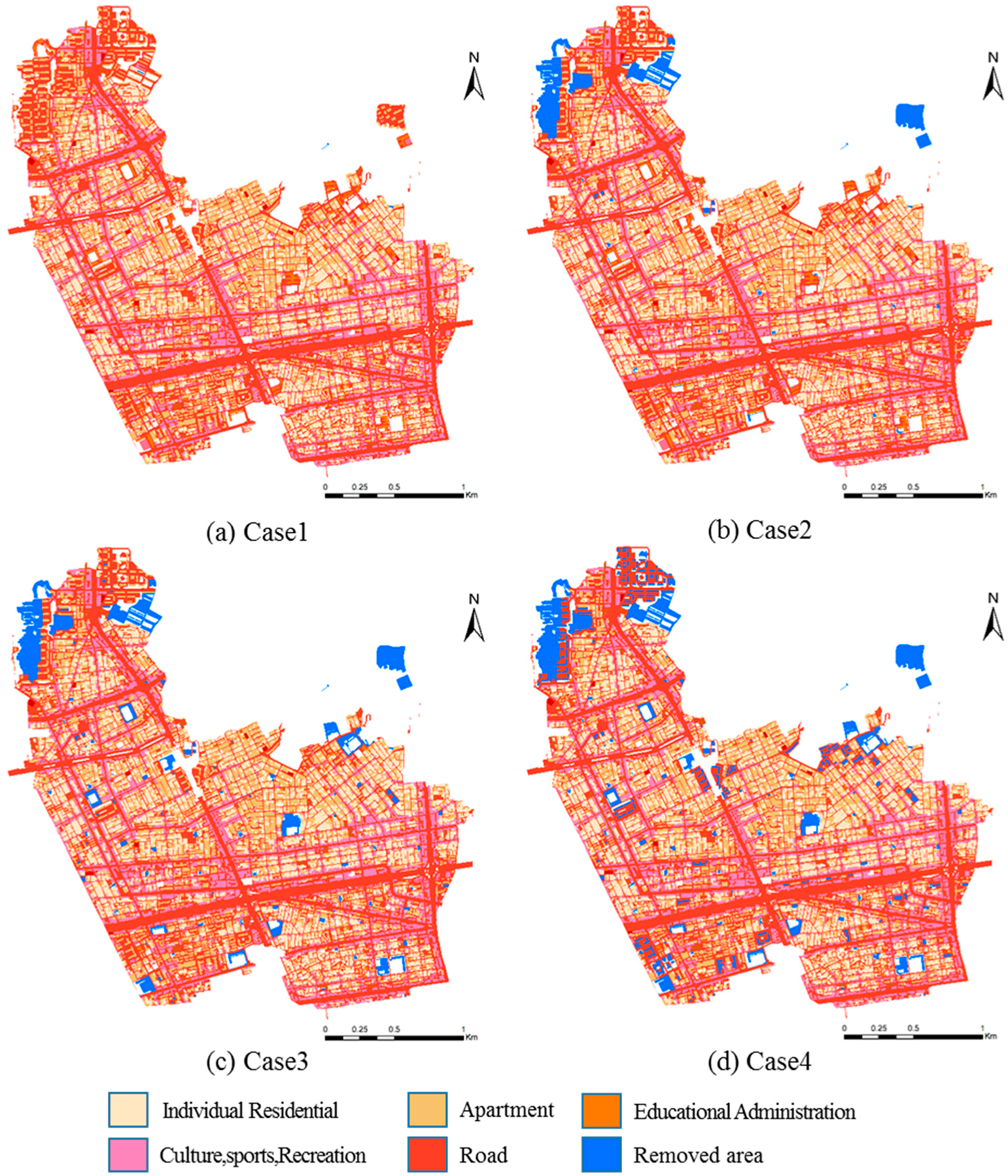
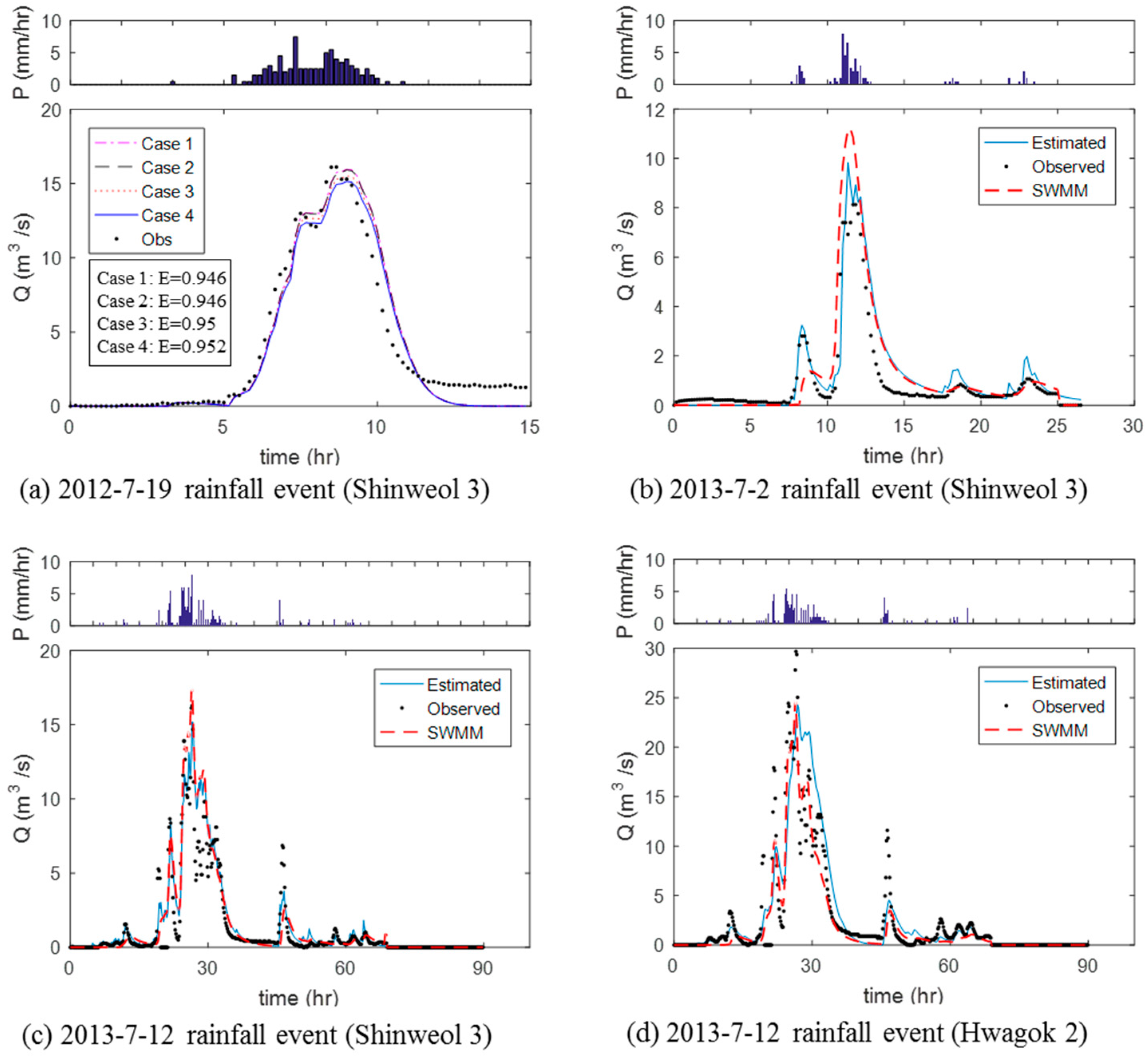
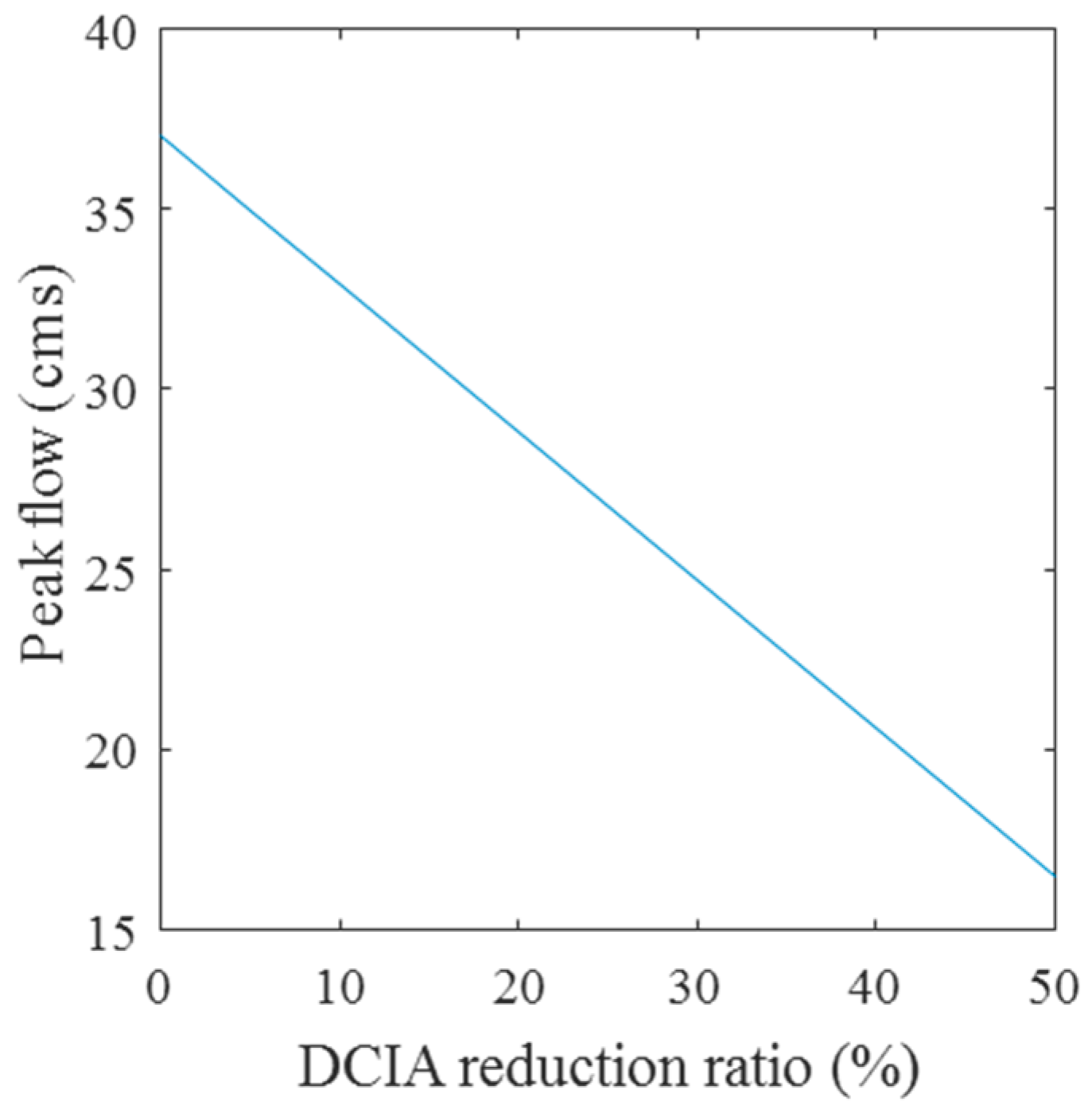
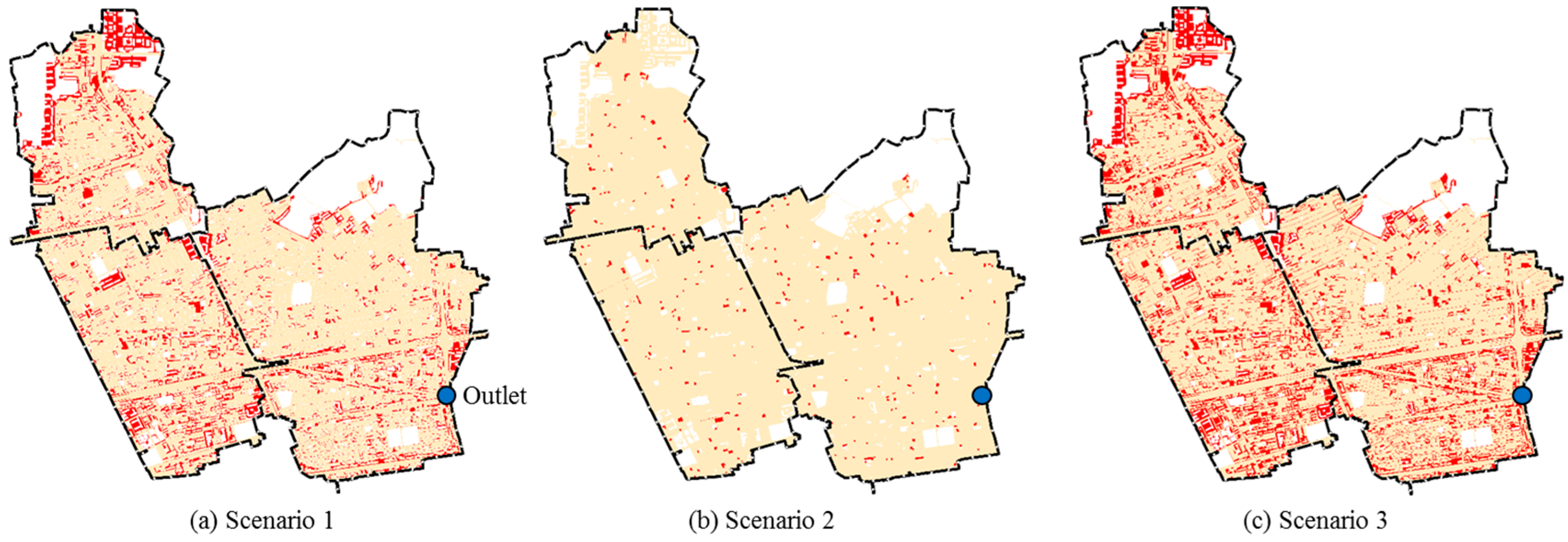


| Low-level Land Cover Data | Mid-level Land Cover Data | High-level Land Cover Data |
|---|---|---|
 |  |  |
| ∙ Spatial resolution: 30 m ∙ Classification: 7 items ∙ Map scale: 1:50,000 ∙ Data: Landsat TM satellite image | ∙ Spatial resolution: 5 m ∙ Classification: 22 items ∙ Map scale: 1:25,000 ∙ Data: Landsat TM + IRS 1C, SPOT5, Arirang 2 satellite image | ∙ Spatial resolution: 1 m ∙ Classification: 41 items ∙ Map scale: 1:5000 ∙ Data: Arirang 2, IKONOS satellite image, Air-Photographs |
| Contribution | Saturation Condition | |
|---|---|---|
| Before Saturation | After Saturation | |
| DCIA | ||
| IIA | ||
| ExPerv | ||
| InPerv | ||
| Catchment | Area (km2) | TIA (km2) | DCIA (km2) | |||
|---|---|---|---|---|---|---|
| Case 1 | Case 2 | Case 3 | Case 4 | |||
| Shinweol 1 | 1.524 | 1.368 | 1.364 | 1.216 | 1.197 | 1.159 |
| Shinweol 3 | 1.725 | 1.674 | 1.674 | 1.670 | 1.636 | 1.605 |
| Hwagok 2 | 3.255 | 2.773 | 2.770 | 2.726 | 2.658 | 2.632 |
| Scenario | Description | DCIA (%) | |||
|---|---|---|---|---|---|
| Present | Applied to Upstream | Applied to Midstream | Applied to Downstream | ||
| Scenario 1 | Convert roads, individual residential and apartment parking lots to permeable pavement | 82.95 | 63.76 | 81.41 | 74.27 |
| Scenario 2 | Redirection of rooftop runoff to infiltration areas | 74.94 | 91.57 | 79.91 | |
| Scenario 3 | Scenario 1 + Scenario 2 | 62.69 | 79.93 | 73.34 | |
| Application Areas | Peak Flows (m3/s) for the Storm Event on 12 July 2013 | |||
|---|---|---|---|---|
| Current State | Scenario 1 | Scenario 2 | Scenario 3 | |
| Entire catchment | 36.96 | 32.98 (−11%) | 36.39 (−2%) | 32.48 (−12 %) |
| Upstream areas | 36.09 (−2%) | 36.83 (−0.5%) | 36.03 (−3%) | |
| Midstream areas | 35.61 (−4%) | 36.73 (−1%) | 35.39 (−4%) | |
| Downstream areas | 35.19 (−5%) | 36.74 (−1%) | 34.97 (−5%) | |
© 2017 by the authors. Licensee MDPI, Basel, Switzerland. This article is an open access article distributed under the terms and conditions of the Creative Commons Attribution (CC BY) license (http://creativecommons.org/licenses/by/4.0/).
Share and Cite
Hwang, J.; Rhee, D.S.; Seo, Y. Implication of Directly Connected Impervious Areas to the Mitigation of Peak Flows in Urban Catchments. Water 2017, 9, 696. https://doi.org/10.3390/w9090696
Hwang J, Rhee DS, Seo Y. Implication of Directly Connected Impervious Areas to the Mitigation of Peak Flows in Urban Catchments. Water. 2017; 9(9):696. https://doi.org/10.3390/w9090696
Chicago/Turabian StyleHwang, Junshik, Dong Sop Rhee, and Yongwon Seo. 2017. "Implication of Directly Connected Impervious Areas to the Mitigation of Peak Flows in Urban Catchments" Water 9, no. 9: 696. https://doi.org/10.3390/w9090696





